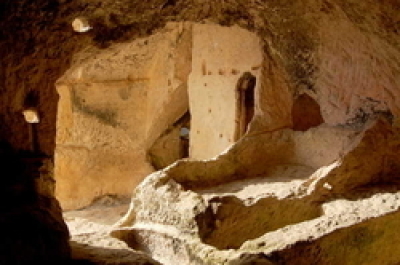Archaeologists shine light on complex relationships of isolated Christian community in medieval Spain

An archaeological study of an isolated Christian community in Spain shines a light on the endogamous community that, despite its proximity to Islamic-controlled regions, had low levels of North African or Middle Eastern ancestries.
Las Gobas is a cave settlement in Iberia that existed from the mid-sixth century to the 11th century A.D. The settlement is notable for the two churches and living areas carved into the caves, which are located north of regions under Islamic rule.
Researchers Anders Götherström and Ricardo Rodríguez Varela, alongside their colleagues at the Centre for Palaeogenetics in Stockholm, analyzed the remains of over 30 individuals buried at Las Gobas. The CPG is a joint venture between Stockholm University and the Swedish Museum of Natural History.
According to a study published Aug. 28 in Science Advances, the team excavated 41 burials and analyzed 39 individual remains. The team genetically identified the sex of 33 individuals, finding that 11 were female and 22 were male. Some of the individuals showed signs of violence, with signs of trauma likely caused by a sword to the skull.
"The presence of consanguinity and violence in the early stages of the necropolis, together with the relatively small variations observed in the Y chromosome, leads to speculation about the possibility that the site was populated in the seventh century CE by a small patrilocal endogamous group that could be, for example, members of an elite with military experience," the study stated.
The study's second phase found more kinship connections and an absence of signs of sword injuries, prompting speculation that the site evolved into a rural farming necropolis. Researchers still found genetic continuity between the two phases, which indicates endogamy was still a practice.
"The geographic location of Las Gobas, surrounded by mountains and relatively distant from urban centers, likely contributes to the community's isolation," the researchers found. "The observed high levels of consanguinity among some individuals from Las Gobas indicate cultural practices of endogamy, which could also limit the gene flow from neighboring communities. This local isolation may, over time, also result in reduced gene flow from Arabs and North Africans on a broader scale."
In a statement to Stockholm University about the research, Varela said that the findings appear to indicate that the community "stayed relatively isolated for at least five centuries."
The author also noted that researchers found low levels of mixing with peoples of North African and Middle Eastern ancestry compared to other medieval inhabitants of the Iberian Peninsula.
Research did not observe an increase in such ancestries after the Islamic conquest of Iberia, Varela stated. The Umayyad Caliphate's conquest of the Iberian Peninsula (711 to 726 A.D.) had what the study's researchers described as a "pronounced genetic influence on most parts of Iberia."
In addition to the genetics of Las Gobas, the study assessed the spread of smallpox in the Middle Ages. Researchers analyzed several pathogens, finding that the community's keeping of animals likely led to the spread of bacteria.
Zoé Pochon of CPG said in a statement that the bacterium Erysipelothrix rhusiopathiae found on Las Gobas human remains can cause skin disease.
The scientist said that the bacterium can cause skin diseases via an open wound making contact with infected animal material. Pochon speculated that this means the Las Gobas community kept animals. One of the individual remains also appears to have been infected with variola virus, which causes smallpox.
"It is amazing how much information we were able to gather on this group of people through our archaeogenetic investigation," Götherström, the study's senior author, stated about the findings.
"An endogamous group, familiar with violence, appears to have established itself in Las Gobas during the 6th or 7th century," he said. "By the 10th century, smallpox seems to have affected Las Gobas, likely spreading through Europe rather than via Islamic routes, as was previously theorized for how smallpox entered Iberia."
Samantha Kamman is a reporter for The Christian Post. She can be reached at: samantha.kamman@christianpost.com. Follow her on Twitter: @Samantha_Kamman





























